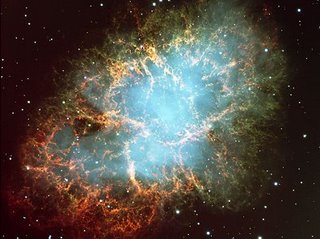Supernova Remnants

_______________________________________________________
The Crab Nebula from VLT Credit: FORS Team, 8.2-meter VLT, ESO
A supernova remnant (SNR) is the structure resulting from the gigantic explosion of a star in a supernova. The supernova remnant is bounded by an expanding shock wave, and consists of ejected material expanding from the explosion, and the interstellar material it sweeps up and shocks along the way.
There are two possible routes to a supernova:
either a massive star may run out of fuel, ceasing to generate fusion energy in its core, and collapsing inward under the force of its own gravity to form a neutron star or a black hole; or a white dwarf star may accumulate (accrete) material from a companion star until it reaches a critical mass and undergoes a thermonuclear explosion.
In either case, the resulting supernova explosion expels much or all of the stellar material with velocities as much as 1% the speed of light, some 3,000 km s-1. When this material collides with the surrounding circumstellar or interstellar gas, it forms a shock wave that can heat the gas up to temperatures as high as 10 million K, forming a plasma.
The Crab Nebula, filled with mysterious filaments, is the result of a star that was seen to explode in 1054 AD. This spectacular supernova explosion was recorded by Chinese and (quite probably) Anasazi Indian astronomers. The filaments are mysterious because they appear to have less mass than expelled in the original supernova and higher speed than expected from a free explosion.
In the above picture taken recently from a Very Large Telescope, the color indicates what is happening to the electrons in differentparts of the Crab Nebula. Red indicates the electrons are recombining with protons to form neutral hydrogen, while blue indicates the electrons are whirling around the magnetic field of the inner nebula. In the nebula's very center lies a pulsar: a neutron star rotating, in this case, 30 times a second.
Perhaps the most famous and best-observed young SNR was formed by SN 1987A, a supernova in the Large Magellanic Cloud that was discovered in 1987. A few other well-known, older, supernova remnants are the Crab Nebula, a remnant of a relatively recent explosion (AD 1054); Tycho (SN 1572), a remnant named after Tycho Brahe, who recorded the brightness of its original explosion (AD 1572); and Kepler (SN 1604), named after Johannes Kepler.
_______________________________________________________
Supernova
Planetary nebula
List of supernova remnants
now-here-is-supernova-for-real by Plato
aftermath of a violent stellar death hubble spacetelescope news
_______________________________________________________
_______________________________________________________
Quote of the Day:
I think; therefore I am. Rene Descartes more Famous Quotes
_______________________________________________________


<< Home